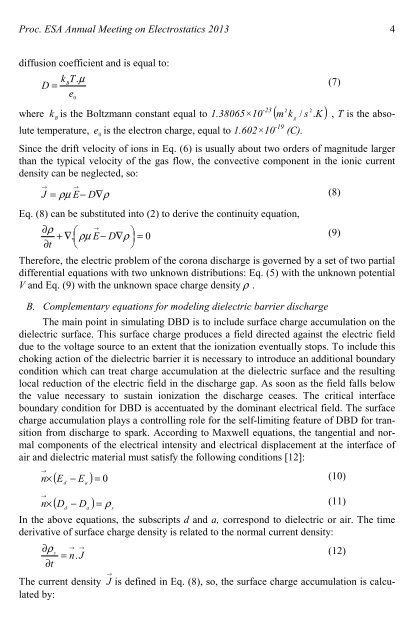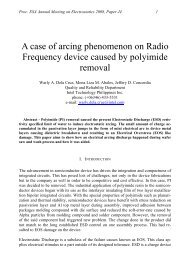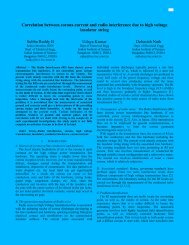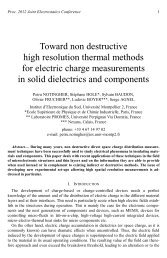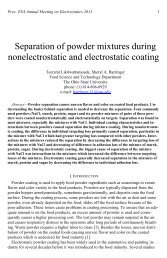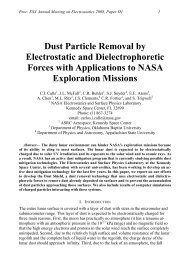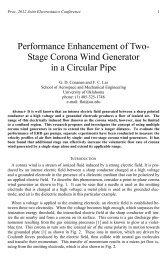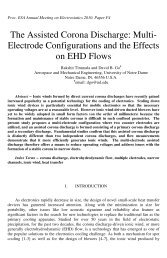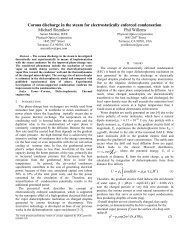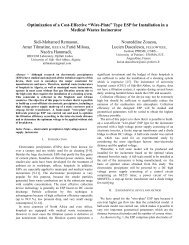Quasi-stationary numerical model of the dielectric barrier discharge
Quasi-stationary numerical model of the dielectric barrier discharge
Quasi-stationary numerical model of the dielectric barrier discharge
Create successful ePaper yourself
Turn your PDF publications into a flip-book with our unique Google optimized e-Paper software.
Proc. ESA Annual Meeting on Electrostatics 2013 4diffusion coefficient and is equal to:wherek T.µBD = (7)eB0k is <strong>the</strong> Boltzmann constant equal to 1.38065×10 -23 2 2( m k g/ s . K ), T is <strong>the</strong> absolutetemperature, e is <strong>the</strong> electron charge, equal to 1.602×10 -19 (C).0Since <strong>the</strong> drift velocity <strong>of</strong> ions in Eq. (6) is usually about two orders <strong>of</strong> magnitude largerthan <strong>the</strong> typical velocity <strong>of</strong> <strong>the</strong> gas flow, <strong>the</strong> convective component in <strong>the</strong> ionic currentdensity can be neglected, so:→→J = ρµ E−D∇ρ(8)Eq. (8) can be substituted into (2) to derive <strong>the</strong> continuity equation,→∂ρ+ ∇. ⎛⎞⎜ ρµ E−D∇ρ⎟ = 0∂t⎝⎠Therefore, <strong>the</strong> electric problem <strong>of</strong> <strong>the</strong> corona <strong>discharge</strong> is governed by a set <strong>of</strong> two partialdifferential equations with two unknown distributions: Eq. (5) with <strong>the</strong> unknown potentialV and Eq. (9) with <strong>the</strong> unknown space charge density ρ .B. Complementary equations for <strong>model</strong>ing <strong>dielectric</strong> <strong>barrier</strong> <strong>discharge</strong>The main point in simulating DBD is to include surface charge accumulation on <strong>the</strong><strong>dielectric</strong> surface. This surface charge produces a field directed against <strong>the</strong> electric fielddue to <strong>the</strong> voltage source to an extent that <strong>the</strong> ionization eventually stops. To include thischoking action <strong>of</strong> <strong>the</strong> <strong>dielectric</strong> <strong>barrier</strong> it is necessary to introduce an additional boundarycondition which can treat charge accumulation at <strong>the</strong> <strong>dielectric</strong> surface and <strong>the</strong> resultinglocal reduction <strong>of</strong> <strong>the</strong> electric field in <strong>the</strong> <strong>discharge</strong> gap. As soon as <strong>the</strong> field falls below<strong>the</strong> value necessary to sustain ionization <strong>the</strong> <strong>discharge</strong> ceases. The critical interfaceboundary condition for DBD is accentuated by <strong>the</strong> dominant electrical field. The surfacecharge accumulation plays a controlling role for <strong>the</strong> self-limiting feature <strong>of</strong> DBD for transitionfrom <strong>discharge</strong> to spark. According to Maxwell equations, <strong>the</strong> tangential and normalcomponents <strong>of</strong> <strong>the</strong> electrical intensity and electrical displacement at <strong>the</strong> interface <strong>of</strong>air and <strong>dielectric</strong> material must satisfy <strong>the</strong> following conditions [12]:→×( − ) = 0n E dE a(10)→n×( D d− D a) = ρsIn <strong>the</strong> above equations, <strong>the</strong> subscripts d and a, correspond to <strong>dielectric</strong> or air. The timederivative <strong>of</strong> surface charge density is related to <strong>the</strong> normal current density:(9)(11)ρ→ →s(12)∂∂t= n.JThe current density → J is defined in Eq. (8), so, <strong>the</strong> surface charge accumulation is calculatedby:


